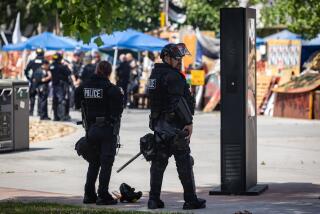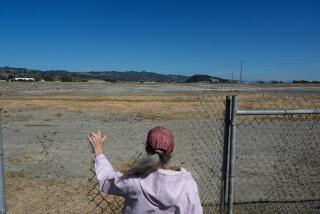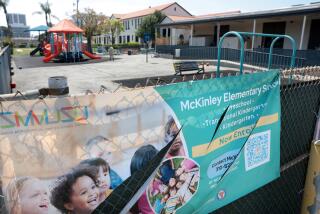Geiger Counter Reading Upstages Rockwell Protest
- Share via
Demonstrators held a news conference Friday to denounce Rockwell International and the federal Department of Energy over cleanup of a former nuclear reactor building, but the company stole the show.
About 25 demonstrators gathered outside Rockwell’s Santa Susana Field Laboratory in the Simi Hills southeast of Simi Valley to criticize a decision by officials to allow radioactivity in the structure to decay to natural background levels instead of removing it at a cost of more than $4.4 million.
But as the news conference ended, Rockwell spokesman Pat Coulter invited reporters to visit the structure, known as Building 24, to see “how highly radioactive it isn’t.”
A convoy of cars then rolled through Santa Susana’s gates carrying more than a dozen reporters and photographers, as well as some protesters who tagged along. Visitors and officials wore no protective gear as they clambered in and out of the bare, 20-foot-high reactor vaults. Officials ran Geiger counters over the walls to show that radiation levels were low, although above natural background.
Afterward, some protesters said they were unconvinced. “You’ve got to clean it up,” said Sheldon Plotkin, one opponent of the plan. “We can’t leave this sort of thing to future generations.”
The Department of Energy and Rockwell are in the midst of a $36-million cleanup of radioactive and chemical pollution at Santa Susana, stemming from past work at the former nuclear development center.
The plan calls for removing contaminated soil and buildings. But contamination in Building 24 is so minor, officials said, that it might as well be left to disappear through natural radioactive decay.
The structure once housed four small experimental reactors, the last of which was removed 19 years ago. Surface contamination was cleaned up, but some of the thick concrete shielding of the reactor vaults became radioactive under neutron bombardment from the reactors.
None of this radioactivity is escaping Building 24, Rockwell officials said. Inside reactor vaults in the basement of the building, radioactivity is 20 to 40 times above natural background levels--or about half the level in the cabin of an airplane cruising at 35,000 feet that is being bombarded by cosmic rays from the sun, they said.
If the building were torn down and the reactor vaults excavated, they said, native soil used to fill the hole would contain more radioactivity than the concrete does.
The cleanup plan instead calls for Rockwell to keep the building locked and monitor it periodically, at a cost of $15,000 per year. It will be 10 to 50 years before radioactivity decays to background levels.
The news conference was sponsored by the Rocketdyne Cleanup Coalition, named for Rockwell’s Rocketdyne Division, which does energy work at Santa Susana for the U.S. Department of Energy.
“Read My Lips. Clean Up Not Seal Up,” said placards carried by some protesters. “Are the Simi Hills to remain a ticking time bomb?” asked Dawn Kowalski, one of the protesters who spoke.
Plotkin, a member of the coalition and the Southern California Federation of Scientists, denounced the money-saving plan. Millions of dollars for cleanup is “the cost we have to pay for . . . violating Mother Earth in the first place,” he said.
Several speakers described the sealing of the building as a sudden departure from the cleanup plan, but in fact the Energy Department and Rockwell disclosed it last fall in a draft of the plan released to the public.
A press release announcing the news conference described the building as containing “highly radioactive material,” but coalition members were unable to support the claim.
Rather, some admitted, they simply did not believe assurances by Rockwell and the Energy Department.
“You know what the main issue is,” said Cliff Rosatt, one of the protesters. “It’s a question of trust.”
Roger Liddle, an Energy Department official, said the agency wants to be sensitive to public concerns. But he said he did not anticipate a change in the decision to seal and monitor the building.
Liddle said the issue will be discussed at a public meeting on the Santa Susana cleanup plan that is tentatively scheduled to be held in Simi Valley Aug. 30.
More to Read
Sign up for Essential California
The most important California stories and recommendations in your inbox every morning.
You may occasionally receive promotional content from the Los Angeles Times.










